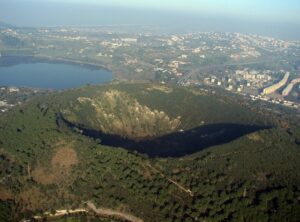
L’analisi dei dati di deformazione e della sismicità registrati nella caldera flegrea tra il 2000 e il 2023 ha permesso di evidenziare la stretta relazione tra sollevamento del suolo e numero di terremoti

Roma, 3 dicembre 2024 – Un team di ricercatori dell’Istituto Nazionale di Geofisica e Vulcanologia (INGV) ha analizzato l’evoluzione della deformazione del suolo e dell’attività sismica ai Campi Flegrei dal 2000 al 2023 quantificando la loro accelerazione nel tempo e derivando una relazione esponenziale tra il sollevamento massimo della caldera e il numero cumulato di eventi sismici.
I risultati, presentati nell’articolo “Accelerating upper crustal deformation and seismicity of Campi Flegrei caldera (Italy), during the 2000-2023 unrest” appena pubblicato sulla rivista Communications Earth & Environment di Nature, derivano dallo studio dei principali segnali geofisici registrati ai Campi Flegrei dalle reti di monitoraggio dell’Osservatorio Vesuviano dell’INGV che la recente evoluzione del bradisismo ha consentito di analizzare approfonditamente.
“Lo studio realizzato – spiega Augusto Neri, ricercatore dell’INGV e coordinatore della ricerca – non adotta a priori modelli fisici specifici bensì si prefigge di rappresentare l’evoluzione della crisi in un modo il più possibile obiettivo e neutro attraverso un’analisi matematica rigorosa dei dati delle reti di monitoraggio geofisico. Attraverso questa analisi è possibile rappresentare, seppur in termini sintetici e approssimati, il comportamento del vulcano ed evidenziare i suoi cambiamenti nel tempo col fine ultimo di migliorare la comprensione del suo funzionamento”.
In particolare, lo studio ha evidenziato la prosecuzione di una accelerazione di lungo periodo (decennale) delle variabili geofisiche iniziata nel 2005 e come questa accelerazione non sia stata costante nel tempo.
“Su scala decennale – spiega Andrea Bevilacqua, ricercatore dell’INGV e primo autore dello studio – il sollevamento del suolo segue un andamento parabolico con un’accelerazione media di circa 0,7-0,8 cm/anno² con riferimento alla stazione GNSS del Rione Terra di Pozzuoli, al centro della caldera. L’andamento temporale del tasso di terremoti è invece sovra-esponenziale, ovvero più rapido di un andamento esponenziale. È comunque importante evidenziare come questi andamenti non siano costanti nel tempo ma soggetti a oscillazioni di varia frequenza. I principali periodi di queste oscillazioni variano da circa 2 a 5 mesi (per i periodi più brevi) fino a circa 1,5 e 3 anni (per i periodi più lunghi). Negli ultimi anni, si è inoltre osservata una tendenza alla riduzione di questi periodi di circa il 10-15%. Una implicazione di questi risultati è che i periodi di ridotta attività sismica non sono necessariamente indicativi di un cambio nel comportamento decennale del vulcano”.
Un aspetto particolarmente interessante dello studio ha riguardato la relazione tra deformazione del suolo e numero di terremoti registrati.
“Lo studio ha evidenziato – prosegue Neri – una chiara relazione esponenziale tra sollevamento massimo della caldera e numero cumulato dei terremoti registrati. Questa relazione è diversa da quella lineare osservata durante l’ultima crisi bradisismica del 1982-1984. Inoltre la relazione esponenziale è diventata più forte a partire dall’anno 2020 circa, ovvero con l’avvicinarsi del sollevamento della caldera alla quota massima raggiunta durante la crisi del 1982-1984. La relazione spiega come mai il sollevamento della caldera registrato negli ultimi anni è stato accompagnato da una più intensa attività sismica rispetto agli anni precedenti. Questo comportamento è analogo a quello dei materiali quasi-elastici soggetti a uno sforzo crescente e può essere interpretato come un progressivo deterioramento delle proprietà meccaniche della crosta più superficiale dei Campi Flegrei”.
Lo studio pubblicato utilizza dati registrati fino a novembre 2023 ma è tuttora continuamente aggiornato sulla base dei nuovi dati di monitoraggio registrati.
“Le analisi aggiornate fino alla fine di ottobre 2024 – conclude Flora Giudicepietro, ricercatrice dell’INGV e coautrice dello studio – confermano che gli andamenti e le relazioni individuate nel periodo 2000-2023 sono tuttora valide. Questo significa che al crescere della velocità di sollevamento aumenta anche la probabilità di terremoti nei Campi Flegrei nei mesi successivi. Un’altra implicazione di questo studio è che, qualora tali andamenti continuassero con le stesse caratteristiche nel futuro, un ulteriore sollevamento della caldera potrebbe essere associato a tassi di attività sismica superiori a quelli registrati nel 2023, come già avvenuto nel maggio 2024. Questo scenario rappresenta una possibile evoluzione futura qualora la crisi bradisismica attualmente in corso dovesse perdurare. D’altra parte, è anche possibile che il processo di sollevamento del suolo flegreo si attenui nel tempo, e questo comporterebbe anche una riduzione dell’attività sismica”.
La ricerca pubblicata ha una valenza essenzialmente scientifica, priva al momento di immediate implicazioni in merito agli aspetti di protezione civile.
*******
Campi Flegrei, quantified the relationship between ground uplift and seismic activity
The analysis of deformation and seismicity data recorded in the Campi Flegrei caldera between 2000 and 2023 highlighted the close relationship between ground uplift and the number of earthquakes
Rome, 3 December 2024 – A team of researchers from the Istituto Nazionale di Geofisica e Vulcanologia (INGV) analyzed the evolution of ground deformation and seismic activity in the Campi Flegrei area from 2000 to 2023. They quantified their acceleration over time and derived an exponential relationship between the maximum uplift of the caldera and the cumulative number of seismic events.
The results, presented in the article “Accelerating upper crustal deformation and seismicity of Campi Flegrei caldera (Italy), during the 2000-2023 unrest” recently published in Nature’s journal Communications Earth & Environment, are based on the study of key geophysical signals recorded at Campi Flegrei by the monitoring networks of the INGV’s Osservatorio Vesuviano. The recent evolution of bradyseism has enabled an in-depth analysis of these signals.
“The study – explains Augusto Neri, INGV researcher and coordinator of the research – does not adopt specific physical models a priori but rather aims to represent the evolution of the crisis as objectively and neutrally as possible through a rigorous mathematical analysis of geophysical monitoring data. This analysis makes it possible to represent, albeit in simplified and approximate manner, the behavior of the volcano and to highlight its changes over time, with the ultimate goal of improving our understanding of its dynamics”.
In particular, the study highlighted the continuation of a long-term (decadal) acceleration of geophysical variables that began in 2005 and showed that this acceleration has not been constant over time.
“On a decadal scale – explains Andrea Bevilacqua, INGV researcher and lead author of the study – ground uplift follows a parabolic trend with an average acceleration of approximately 0.7-0.8 cm/year², based on data from the GNSS station at Rione Terra in Pozzuoli, located at the center of the caldera. The temporal trend of the earthquake rate is instead super-exponential, meaning it increases faster than an exponential trend. It is important to emphasize, however, that these trends are not constant over time but subject to oscillations of varying frequency. The main periods of these oscillations range from about 2 to 5 months (for shorter periods) to approximately 1.5 and 3 years (for longer periods). In recent years, there has also been a tendency towards a reduction of these periods by about 10-15%. One implication of these results is that periods of reduced seismic activity are not necessarily indicative of a change in the decadal behavior of the volcano”.
A particularly interesting aspect of the study concerned the relationship between ground deformation and the number of recorded earthquakes.
“The study highlighted – continues Augusto Neri – a clear exponential relationship between the maximum uplift of the caldera and the cumulative number of recorded earthquakes. This relationship is different from the linear one observed during the last bradyseismic crisis of 1982-1984. Furthermore, the exponential relationship became stronger starting around 2020, as the caldera uplift approached the maximum height reached during the 1982-1984 crisis. This relationship explains why the caldera uplift recorded in recent years has been accompanied by more intense seismic activity compared to previous years. This behavior is similar to that of quasi-elastic materials subjected to increasing stress and can be interpreted as a progressive deterioration of the mechanical properties of the upper crust of Campi Flegrei”.
The study published uses data recorded up to November 2023 but is continuously updated based on new monitoring data.
“The analyses updated until the end of October 2024 – concludes Flora Giudicepietro, INGV researcher and co-author of the study – confirm that the trends and relationships identified in the period 2000-2023 are still valid. This means that, as the rate of uplift increases, the probability of earthquakes in the Campi Flegrei in the following months also increases. Another implication of this study is that, should these trends continue with the same characteristics in the future, further uplift of the caldera could be associated with seismic activity rates higher than those recorded in 2023, as already happened in May 2024. This scenario represents a possible future evolution if the ongoing bradyseismic crisis persists. On the other hand, it is also possible that the ground uplift process in the Campi Flegreicould slow down over time, which would also lead to a reduction in seismic activity”.
The published research has primarily scientific significance and, at the moment, does not have immediate implications regarding civil protection aspects.

 Salva come PDF
Salva come PDF







































































